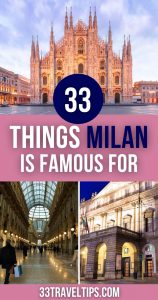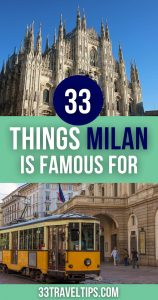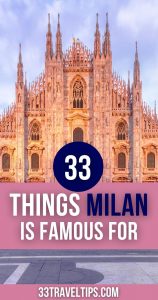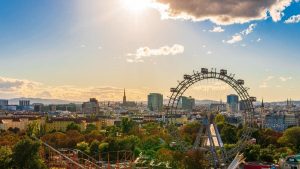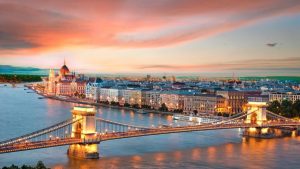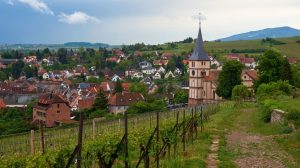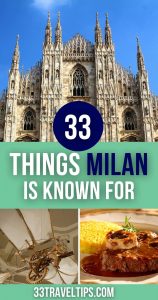
Milan is known for the majestic Duomo Cathedral, the prominent opera La Scala, the medieval Sforza Castle, the dazzling Vittorio Emanuele II shopping arcade, and Leonardo Da Vinci’s legacy. Milan is also famous for its art, history, architecture, and football, as well as extraordinary fashion and culinary scenes.
On this list, you’ll find 33 cool things Milan is known for.
From scrumptious food to extravagant fashion, and from imposing cathedrals to extraordinary art galleries, discover what Milan is famous for.
Ready to dive into the Milanese lifestyle?
Let’s jump right in!
Start Planning Your Trip to Milan with Our BEST Recommendations:
⭐ Top Tours in Milan ⭐
📍 Milan Historical Walking Tour – visit the highlights of Milan’s Renaissance history and skip the lines to see Da Vinci’s “The Last Supper”.
📍 Pasta and Risotto Cooking Class – explore Milan’s central market and learn how to prepare authentic Italian dishes in a fun and entertaining environment.
⭐ Best Accommodations in Milan ⭐
🏨 iQ Hotel Milano – our top pick is this 4* gem near Milano Centrale.
🏨 Heart Milan Apartments Duomo Colonne – funky lodging near the Duomo.
⭐ Easiest Transportation Options in Milan ⭐
🚍 The Milan Pass City Card – enjoy discounts, free travel, and entrances to museums.
🚍 Discover Cars – compare and find the best rates for car rentals.
✅ Note: This article contains affiliate links. In case you purchase something through one of these links, we may receive a small commission at no extra cost to you. Thank you for helping us keep creating the free content on this website!
The Most Popular Attractions Milan Is Known for
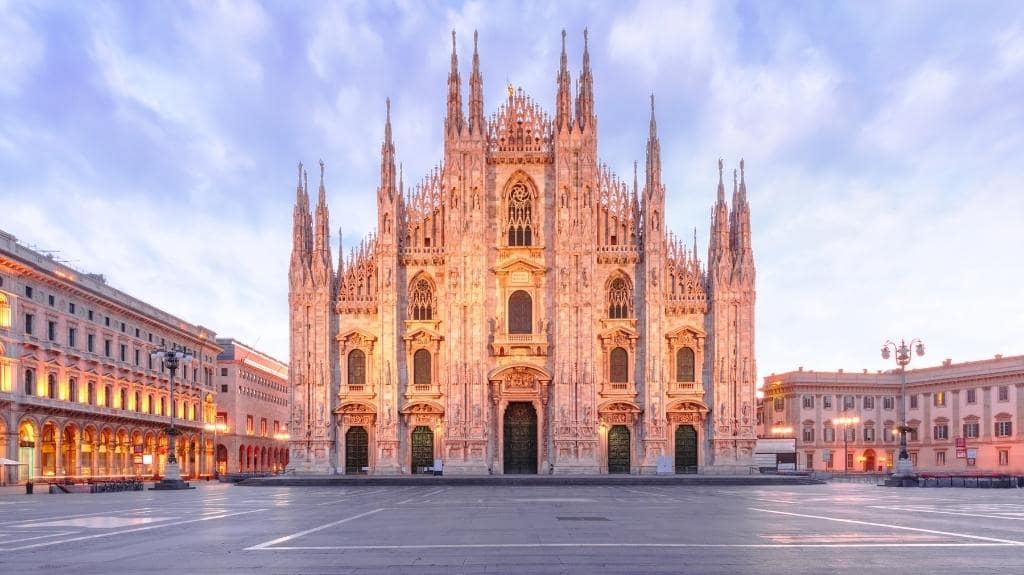
The landmarks of the North Italian city are among the main reasons for its popularity with tourists. Below, you’ll find the top attractions Milan is famous for.
- The grand Duomo. The Milan Cathedral, also known as Nativity of Saint Mary, is one of the largest and most magnificent Gothic churches in the world. The marble edifice can accommodate 40,000 people. More than 130 spires adorn its roof, which rises 354 ft. (108 m) above Piazza Duomo. The enormous building took an unbelievable 579 years to finish. Nowadays, Duomo is one of the top reasons to visit Milan. To avoid crowds, we recommend exploring it early in the morning and purchasing tickets online.
- The prominent Teatro alla Scala. Milan is home to one of the best opera houses in the world. The 18th-century La Scala has hosted every famous Italian opera singer. Many of the greatest performers from around the world have also charmed the Milanese audience. Even if you don’t attend the opera in the evening, you can still tour the graceful building during the day.
- The marvelous Sforzesco Castle. Dating back to the 15th century, the massive medieval fortress is one of Milan’s top attractions. The gigantic structure houses more than 10 museums inside. And while entrance to the castle is paid, exploring its breathtaking exterior and courtyard is free. We recommend getting your tickets in advance to avoid waiting in line. Inside the castle, you’ll have the chance to admire masterpieces by Leonardo da Vinci and Michelangelo.
- The essential Santa Maria delle Grazie. A large, 15th-century edifice houses the Holy Mary of Grace church and Dominican convent. The temple is a UNESCO World Heritage Site. It features intricate terracotta walls and an elaborate Gothic interior. Its biggest treasure is Leonardo da Vinci’s most famous fresco, The Last Supper. The entrance to the church is free, but you need a ticket to see the mural in the refectory of the convent.
- The antique Basilica di Sant’Ambrogio. This Romanesque church from the 4th century is one of the oldest in Milan. During its existence, its exterior changed multiple times. Nowadays, the structure features brickwork of different origins and colors. Explore the graceful courtyard before entering the basilica. Inside, you can pay respect to the Saints Ambrose, Gervasius, and Protasius. Their remains rest in the crypt behind the altar.
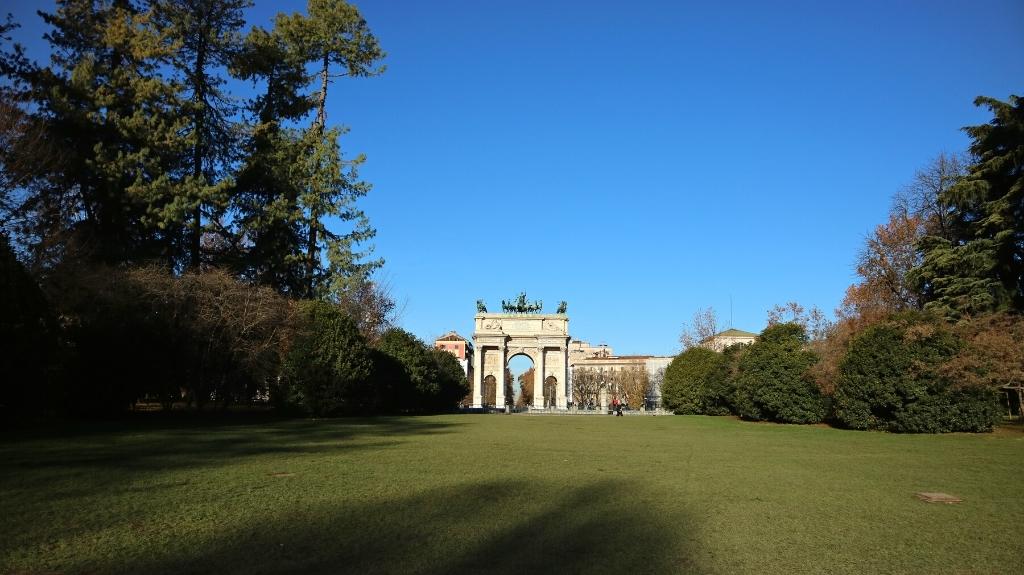
- The enormous Sempione Park. The historic garden is the most famous green space in Milan. It sits between two other top attractions. The gorgeous Sforzesco Castle is on the southeast end, while the striking triumphal Arco della Pace awaits you on the northwest exit. The park prides itself on countless manicured lawns and historic monuments. An artificial pond, a tower, and an aquarium also await to charm you in Sempione Park.
- The Roman Colonne di San Lorenzo. The high, marble columns date back to Roman Times. Back then, Milan was the capital of the Western Roman Empire. An imposing statue of Emperor Constantine faces the archeological site. Behind the statue, you’ll find the 4th-century Basilica San Lorenzo Maggiore. Exploring the Columns of St. Lawrence is one of the best free things to do in Milan.
- The eerie Cimitero Monumentale. The most unusual attraction of Milan is the Monumental Cemetery. If you decide to visit this spooky landmark, be respectful of the dead. The park is the final resting place of prominent artists, architects, and wealthy citizens. Magnificent funerary sculptures in various architectural styles adorn their tombs and make you think about the legacy we leave behind.
- Milan’s defensive gates. Throughout the centuries, the city walls underwent several transformations. Three different systems protected Milan as it grew in size. The oldest walls were built by the Romans. During the Middle Ages, the expanding city updated its defense to accommodate the increasing population. The newest city walls were erected in the 16th century when the Spanish conquered Milan. Nowadays, several of the remaining gateways are worth exploring. You shouldn’t miss Porta Ticinese Medievale, Porta Venezia, and Porta Garibaldi. Each comes from a different era and represents a different architectural style.
- The exceptional San Siro Stadium. The official name of the sports arena is Stadio Giuseppe Meazza, but it’s commonly known as San Siro Stadium. It’s the largest Italian stadium and one of the biggest in Europe. Over 80,000 fans can simultaneously watch their favorite team’s game. What’s unique about San Siro is that it hosts not one but two world-famous football teams – A.C. Milan and Internazionale (more popular as simply Inter). A museum showcases trophies and memorabilia of the two squads. Apart from sports games, the stadium also holds concerts and live events regularly.
The Prominent and Influential Citizens of Milan
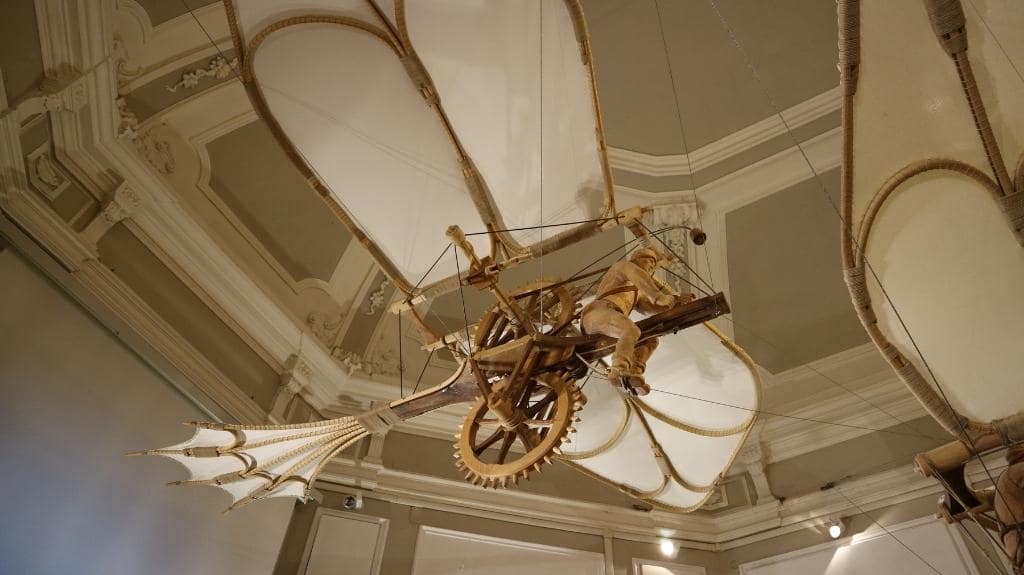
Painters, poets, musicians, and politicians shaped the faith of modern Milan. Their legacy made the city a vital part of the Italian unification and artistic world. In this section, explore the genius of the great minds who called Milan home.
- The multidimensional genius Leonardo da Vinci. Born in the Republic of Florence, Leonardo spent many of his active years in Milan. During his Milanese periods, he created the immortal Virgin of the Rocks and The Last Supper. Additionally, the Duke of Milan commissioned him to paint the Sala delle Asse (“Hall of the Wooden Planks”) in the Sforza Castle. The massive 12-volume Codex Atlanticus was also partially created in Milan. You can marvel at the priceless masterpiece at the Ambrosian Library. You can also explore the master’s mechanical inventions at the Museum of Science and Technology and at Leonardo 3.
- The musical genius Giuseppe Verdi. The famous 19th-century opera composer spent a large portion of his career in Milan. He composed his first operas for the Milanese Teatro alla Scala, which skyrocketed his long career. His most prominent works include Rigoletto, The Troubadour, and La traviata. You can explore his relationship with La Scala and the women in his life in the theater’s museum.
- The diplomatic Sforza Family. The influential dynasty began with Francesco I Sforza who became the Duke of Milan in 1450. Under his rule, the city blossomed. He restored the Royal Palace, constructed the Naviglio d’Adda channel, and rebuilt the Sforza Castle. The Duke was an extraordinary diplomat whose policies kept the peace with Milan’s neighbors for centuries. His successor Ludovico commissioned famous painters, such as Leonardo da Vinci and Bramante, to decorate Sforza Castle. You can still see their exceptional frescoes if you visit the museums in the medieval fortification.
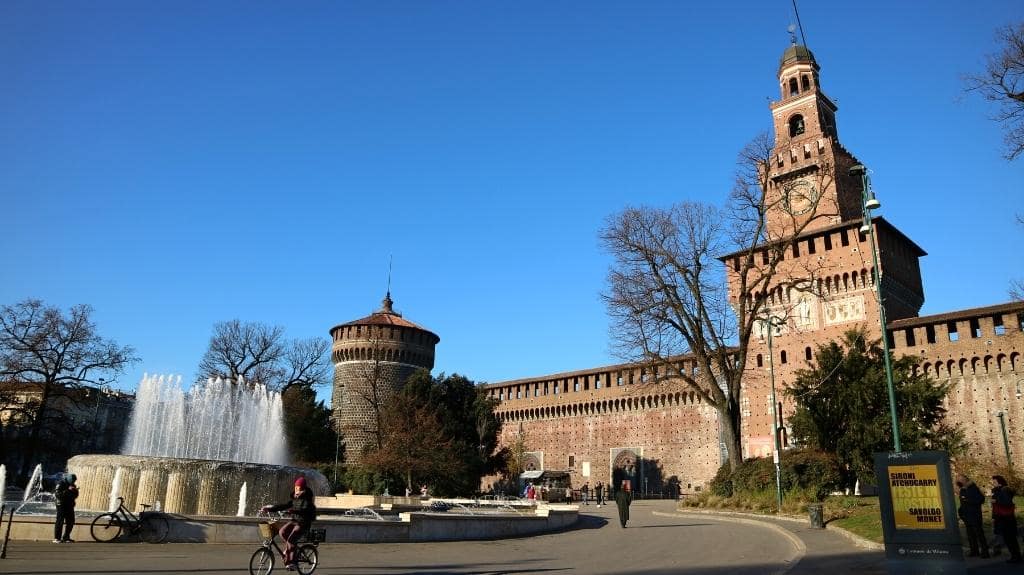
- The influential Alessandro Manzoni. The Milanese poet, novelist, philosopher, politician, and linguist is most famous for his novel The Betrothed. The book is considered one of the masterpieces of world literature. Its significance is in the patriotic messages it contains and the fact that it was an essential milestone in the development of the contemporary Italian language. Manzoni supported the unification of Italy and helped the cause as a member of the Italian Senate. His legacy was important and well-recognized. His death shook the nation. His greatest monument was Giuseppe Verdi’s Requiem, written in honor of his life’s work.
- The patron of art Gian Giacomo Poldi Pezzoli. The Count was a great art lover. His Italian Renaissance collection became one of the first private museums in Italy. The elegant Poldi Pezzoli Museum in the count’s former townhouse contains sculptures, paintings, furniture, and archaeological artifacts. The exhibition displays masterpieces by Italian and Flemish masters, such as Botticelli, Canaletto, Tiepolo, and Cornelis de Wael. Don’t miss a chance to marvel at the invaluable Lamentation over the Dead Christ with Saints or the Madonna of the Book by Sandro Botticelli.
- The powerful Silvio Berlusconi. The controversial Italian media mogul and politician was the Prime Minister of Italy in four governments in the mid-1990s and early 2000s. Constantly ranked by Forbes as one of the most powerful and richest people on the planet, Berlusconi owns control of Mediaset, the largest Italian broadcaster. For years, he also owned the football club A.C. Milan. Although he was convicted of tax fraud in 2013, his political career didn’t die. In 2019, the authoritarian leader became a member of the European Parliament. At age 83, he was the oldest member of the assembly.
- The captain Paolo Maldini. Regarded as one of the greatest defensive footballers of all time, the former Italian national player spent his whole career in his hometown’s A.C. Milan. He won seven Italian titles with his club, five UEFA Champions League finals, and countless other trophies. He’s also one of the few athletes who played in the impressive four FIFA World Cups with Italy’s national team. You can explore The Captain’s legacy at the San Siro Stadium’s Museum.
The Endless Shopping Extravaganzas That Make Milan Special
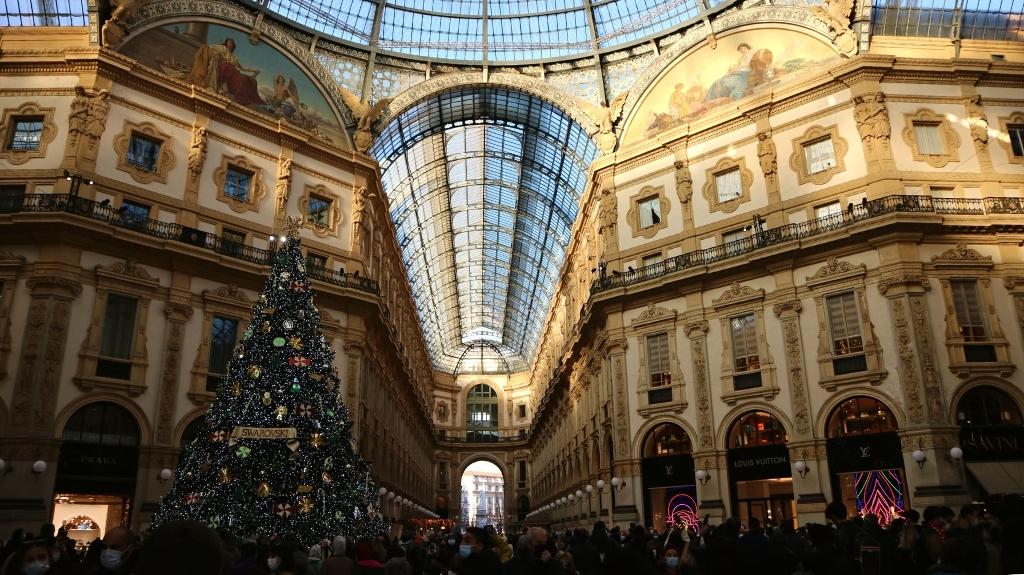
Apart from prominent citizens and breathtaking architecture, Milan is also famous as one of the four fashion capitals of the world. Together with Paris, London, and New York, the Italian city sets style trends and astonishes shopping fans.
In this section, we’ll explore Milan’s most popular shopping areas. Fashion boutiques, brand outlets, and shiny antiquities await you with their most enticing deals.
- The luxe Galleria Vittorio Emanuele II. Built between 1865 and 1877, the luxury shopping arcade is one of the oldest in the world. Nowadays, famous brands, classy restaurants, upscale hotels, and intriguing museums fight for your attention (and cash) in the glass-covered historic mall. However, take your time to admire the architecture of the building for free, instead of browsing the extravagant offers in the boutiques. Intricate mosaics featuring the coats of arms of Milan, Turin, Florence, and Rome decorate the floors, while an elaborate iron-and-glass roof covers the arcade.
- The posh Fashion District. As one of the fashion capitals of the world, Milan surely deserves a whole neighborhood dedicated to the latest trends. You’ll find the extravagant shopping area Quadrilatero della Moda concentrated around Via Monte Napoleone. In the area, expect to be seduced by exclusive boutiques, antique shops, and trendy cafés. In the boutiques, explore the latest collections of top designers, presented in vibrant colors, unique shapes, and funky environments.
- The graceful Via Dante. Stretching between Piazza Duomo and Sforzesco Castle, you can explore the stunning pedestrian Via Dante. Elegant historical townhouses line the avenue. In the street named after the great poet, you’ll find stylish shops, classy restaurants, posh cafés, and trendy bars. In the stores, you can shop for anything from clothing, shoes, and jewelry to books, wine, and cosmetics.
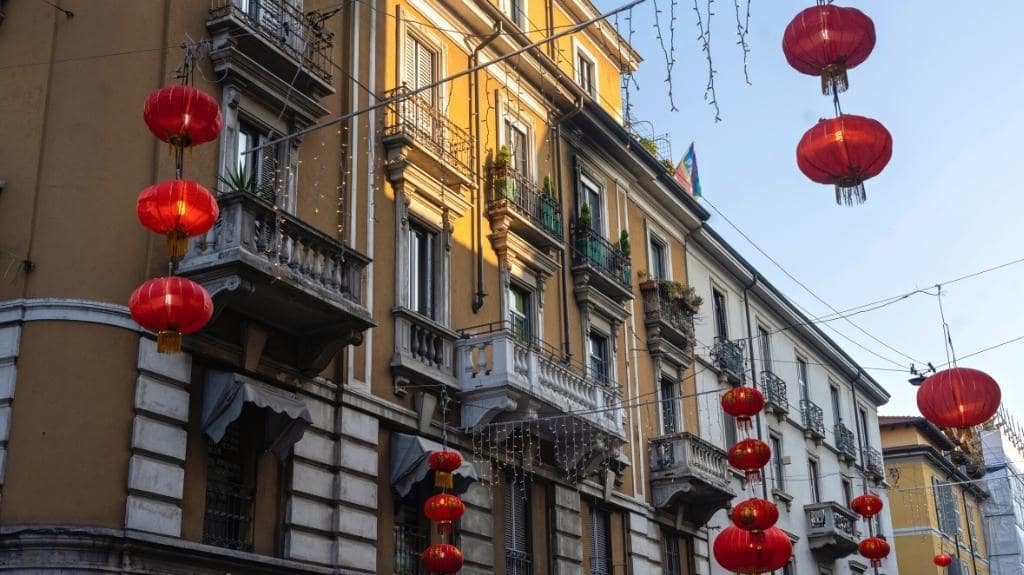
- The bustling Corso Buenos Aires. The mile-long street runs from Porta Venezia to Piazzale Loreto. The lively boulevard houses anything from fashion boutiques through department stores to discount outlets. You can find clothes for all ages, books for all tastes, and fragrances for all occasions. Finish your shopping spree by relaxing with a drink in one of the numerous inviting cafés or replenishing your energy with a hearty meal in one of the cozy restaurants.
- The quirky Chinatown. Dissected by the pedestrianized Via Paolo Sarpi, the multi-ethnic Quartiere Cinese is home to Italy’s largest Chinese community. Red lanterns decorate the streets of the district. You’ll find exotic markets, health stores, hairdressing salons, and traditional restaurants. You can bargain for high-quality silk, cotton, and leather goods at affordable prices. Tip: We recommend Chinatown as one of the best areas to stay in Milan as well.
- The vibrant Milanese antiques and flea markets. Several markets in Milan offer great opportunities for treasure hunting. In Navigli, visit the Viale Papiniano Flea Market and the monthly Mercatone dell’Antiquariato. They’ll seduce you with a great variety of hand-made jewelry, leather goods, old-fashioned furniture, and other exciting antiquities. In Isola, one of the coolest sights you can experience is the weekend market. Buy anything from vintage clothes to cheap attire, and from fresh veggies to aged cheeses from the stalls and tables placed directly on the street.
The Delectable Food Milan Is Known For
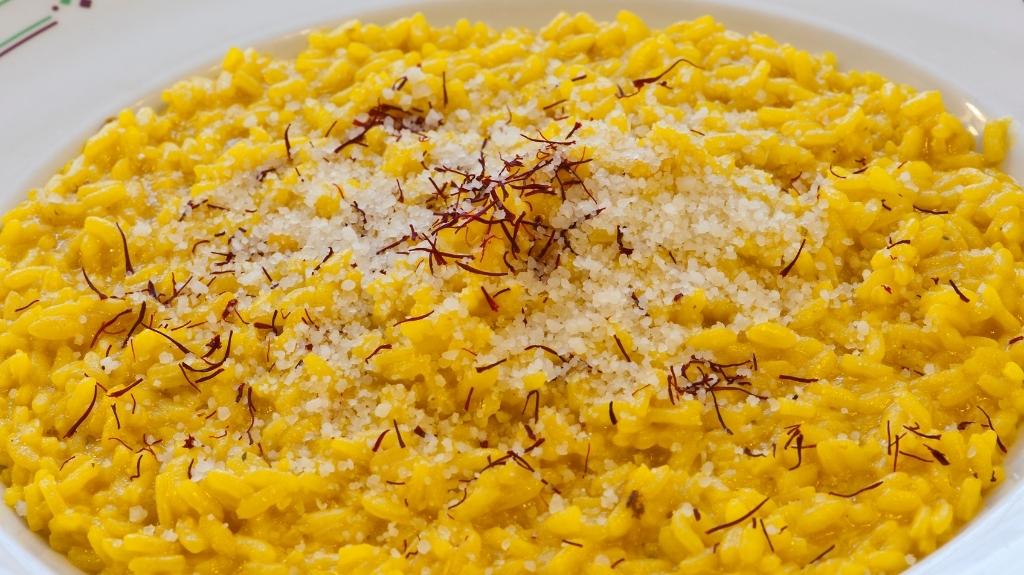
Italian cuisine is beloved and popular worldwide. When exploring North Italy, make sure you sample at least some of the dishes Milan is known for. Now, arm yourself with a napkin and discover the most drooling Milanese meals.
- The vibrant Minestrone alla Milanese. You can enjoy this staple soup all year round. Devour it cold in summer and hot in winter. In the minestrone, fresh seasonal vegetables join forces with pork rind and rice. Beets, cabbage, celery, lettuce, spinach, fennel, and parsley, as well as potatoes, onions, and carrots, simmer in the pot. The result? A colorful and tasty chowder you’ll quickly fall in love with.
- The diverse Polenta. This traditional cornmeal dish comes in several varieties. You can sample polenta as a hot porridge or as a solid loaf. The preparation starts by boiling the corn. If you allow the porridge to cool and solidify, you can bake, fry, or grill it to a loaf. Polenta goes well with cheese, sausages, lentils, or sauces. We should warn you that this meal takes a long time to prepare, so make sure to order it before you feel hungry.
- The creamy Risotto alla Milanese. The typical golden hue of the Milanese risotto comes from the fragrant saffron. The rice dish is a velvety fusion of bone marrow, beef broth, butter, onion, and Parmesan cheese. The comforting dish perfectly balances the starchy rice with the sweet taste of the marrow in a delectable fusion that excites the taste buds.
- The divine Ossobuco. This scrumptious casserole pairs well with risotto and polenta as a side dish. Literally meaning “bone with a hole”, the name of the North-Italian dish refers to the marrowbone at the center of the meat. For a splash of color and taste, add the quintessential gremolada right at the end. The fine paste features parsley, garlic, and lemon zest.
- The calorie-rich Cassoeula. Another staple casserole, cassoeula combines pork head, ribs, or rind with Verzino sausage, onions, carrots, celery, and black pepper. The party simmers for about 2:30 hours, after which you add cabbage to the pot and let it cook for additional 30 minutes. Enjoy the winter dish with polenta and a strong red wine for the ultimate calorie boost.
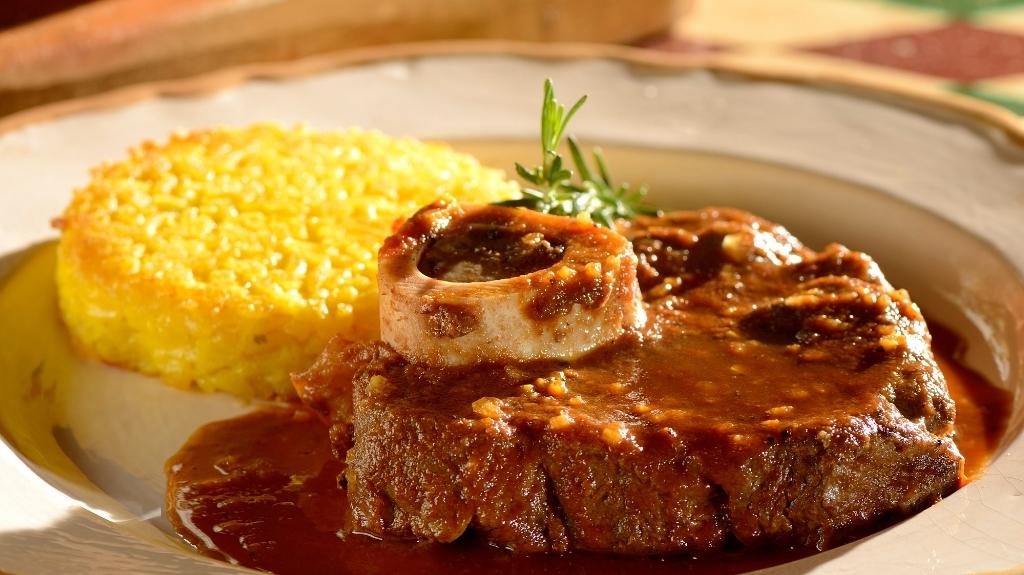
- The crispy Costoletta alla Milanese. Similar to the legendary Viennese Schnitzel, this is one of Milano’s oldest traditional dishes. The recipe for the fried veal cutlet is strictly regulated. You can only use cutlets with a bone from a milk-fed veal. The reason? They’re neither too fat nor too lean. You should also fry the breaded cutlet in nothing but butter.
- The tender Arrostino annegato. This traditional Milanese dish joins boned veal loin and pancetta cured meat. Seasoned with sage and rosemary, the meat is stewed in brown stock, white wine, and lemon juice, until it’s juicy and tender as the night. You can consume the resulting scrumptiousness with risotto.
- The appetizing Mondeghili. The origin of the fried meatballs is in Arabic cuisine. Chefs soak the meat in milk to achieve the ultimate tenderness. The heavenly taste of the mouth-watering snack is also due to the mix of herbs and spices used. Lemon zest, garlic, parsley, nutmeg, and grated Parmesan cheese enhance the flavors. Consume mondeghili as a starter or as a main course with a side dish of rice. Typically, you’ll find them during the traditional Milanese aperitivo, a pre-dinner drink locals love to enjoy after work.
- The classic Michetta. This staple Milanese bread roll is a variation of the Kaisersemmel. During the Austrian rule of Northern Italy, locals started making their version of the famous Vienna roll. In Milan, the pastry is prepared sweet or savory, and can be baked with or without a filling. Always devour michettas freshly baked, as they get stale quite quickly due to their hollow interior and crunchy crust.
- The frothy Barbajada. The popular caffeine drink incorporates equal parts of whipped cream, chocolate, and coffee. Invented in the Caffé del Teatro near La Scala, it quickly became the favorite sweet treat of the famous composer Gioacchino Rossini. The drink was so popular during the 19th and early 20th centuries, it made its inventor comfortably rich.
How Many of the Things Milan is Famous for Did You Already Know?
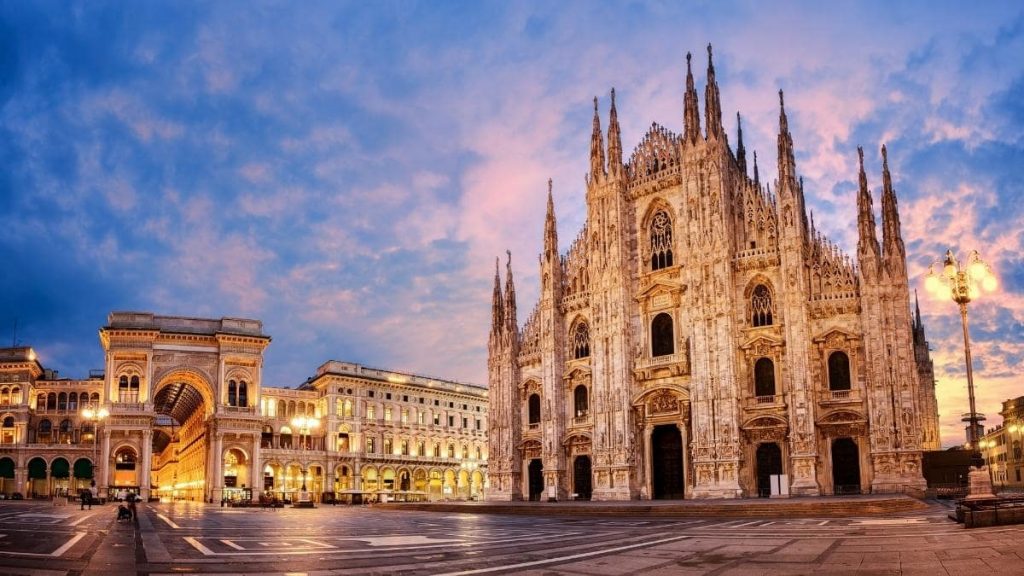
There you have it – the top 33 things Milan is known for.
The Italian city will seduce you with its stunning landmarks, shopping extravaganzas, and scrumptious delicacies.
To make the most of your Italian adventure, leave enough time to explore the country on these awesome day trips from Milan.
Start Planning Your Trip to Milan with Our BEST Recommendations:
⭐ Top Tours in Milan ⭐
📍 Milan Historical Walking Tour – visit the highlights of Milan’s Renaissance history and skip the lines to see Da Vinci’s “The Last Supper”.
📍 Pasta and Risotto Cooking Class – explore Milan’s central market and learn how to prepare authentic Italian dishes in a fun and entertaining environment.
⭐ Best Accommodations in Milan ⭐
🏨 iQ Hotel Milano – our top pick is this 4* gem near Milano Centrale.
🏨 Heart Milan Apartments Duomo Colonne – funky lodging near the Duomo.
⭐ Easiest Transportation Options in Milan ⭐
🚍 The Milan Pass City Card – enjoy discounts, free travel, and entrances to museums.
🚍 Discover Cars – compare and find the best rates for car rentals.
Now, we’re eager to learn:
What’s the first association that comes to mind when you hear Milan, Italy?
Share your thoughts in the comments below.
